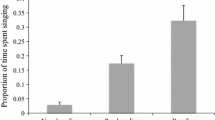Abstract
In this study we examine male song output as a measure of nest site quality in blackcaps (Sylvia atricapilla). Song rate, breeding success, predation on nests and reaction to playbacks were investigated in individual males. Habitat features determining nest site and song post quality in terms of vegetation cover were compared between successful nests and nests that had suffered predation. We then related song rate of unmated males to habitat factors in territories and nesting sites in order to examine a possible predictor function of blackcap song for habitat quality. Several habitat features are responsible for variation in nesting success. These features also correlate with song rate of unmated males. The study indicates a potential role of song rate in the advertisement of territory quality. Furthermore, the data suggest that females use song rates rather than territory quality in mating decisions. The information females may gain about male quality in relation to territory quality are also discussed.
Similar content being viewed by others
References
Alatalo RV, Gustafsson L, Lundberg A (1986) Do females prefer older males in polygynous species? Am Nat 127:241–245
Andersson M (1982) Sexual selection, natural selection and quality advertisement. Biol J Linn Soc 17:375–393
Backhaus K, Erichson B, Plinke W, Weiber R (1990) Multivariate Analysemethoden, 6th edn. Springer, Berlin Heidelberg New York
Berthold P, Querner U, Schlenker R (1990) Die Mönchsgrasmücke (Neue Brehm Bücherei 603). Ziemsen, Wittenberg Lutherstadt
Catchpole CK (1980) Sexual selection and the evolution of complex songs among European warblers of the genus Acrocephalus. Behaviour 74:149–166
Dahlgren J (1990) Females choose vigilant males: an experiment with the monogamous grey partridge, Perdix perdix. Anim Behav 39:646–651
Davies NB, Lundberg A (1985) Food distribution and a variable mating system in the dunnock, Prunella modularis. J Anim Ecol 53:895–912
Dunn JE (1981) Data-based transformations in multivariate analyses. In: Capen DE (ed) The use of multivariate statistics in studies of wildlife habitat (General technical report RM-87). US Department of Agriculture, Fort Collins, pp. 93–103
Gottlander K (1987) Variation in the song rate of the male pied flycatcher Ficedula hypoleuca: causes and consequences. Anim Behav 35:1037–1043
Grafen A (1990) Biological signals as handicaps. J Theor Biol 144:517–546
Greig-Smith PW (1982) Song-rates and parental care by individual male stonechats (Saxicola torquata). Anim Behav 30:245–252
Hasson O (1991) Pursuit-deterrent signals: communication between prey and predator. Trends Ecol Evol 6:325–329
Hiebert SM, Stoddart PK, Arcese P (1989) Repertoire size, territory acquisition and reproductive success in the song sparrow. Anim Behav 37:266–273
Hoi-Leitner M, Nechtelberger H, Dittami J (1993) The relationship between individual differences in male song frequency and parental care in blackcaps. Behaviour 126:1–12
Howard RD (1974) The influence of sexual selection and interspecific competition on mockingbird song (Mimus polyglottos). Evolution 28:428–438
Hutchinson JMC, McNamara JM, Cuthill IC (1993) Song, sexual selection, starvation and strategic handicaps. Anim Behav 45: 1153–1177
Kodric-Brown A, Brown JH (1984) Truth in advertising: the kinds of traits favored by sexual selection. Am Nat 124:795–811
Ludwig JA, Reynolds JF (1988) Statistical ecology. Wiley, New York
McGregor PK, Krebs JR, Perrins CM (1981) Song repertoires and lifetime reproductive success in the great tit (Parus major). Am Nat 118:149–159
Møller AP (1983) Song activity and territory quality in the corn bunting Miliaria calandra; with comments on mate selection. Ornis Scand 14:81–89
Morton ES (1982) Grading, discreteness, redundancy and motivation-structural rules. In: Kroodsma DE, Miller EH (eds) Acoustic communication in birds, vol 1. Academic Press, New York, pp. 183–212
Nur N (1984) Feeding frequencies of nestling blue tits (Parus caeruleus): costs, benefits, and a model of optimal feeding frequency. Oecologia 65:125–137
Oppermann R (1989) Ein Meßinstrument zur Ermittlung der Vegetationsdichte in grasig-krautigen Pflanzenbeständen. Nat Landschaft 64:332–338
Pflumm W, Comtesse H, Wilhelm K von (1984) Sugar concentration and the structure of the sunbird's song. Behav Ecol Sociobiol 15:257–261
Radesäter T, Jakobsson S (1989) Song rate correlation of replacement territorial willow warblers Phylloscopus trochilus. Ornis Scand 20:71–73
Radesäter T, Jakobsson S, Andbjer N, Bylin A, Nyström K (1987) Song rate and pair formation in the willow warbler Phylloscopus trochilus. Anim Behav 35:1645–1651
Redondo T, DeReyna LA (1988) Locatability of begging calls in nestling altricial birds. Anim Behav 36:653–661
Reid ML (1987) Costliness and reliability in the singing vigour of Ipswich sparrows. Anim Behav 35:1735–1743
Reid ML, Weatherhead PJ (1990) Mate-choice criteria of Ipswich sparrows: the importance of variability. Anim Behav 40:538–544
Rhisart A ap (1989) Communication and anti-predator behaviour. D.Phil. thesis, University of Oxford
Searcy WA (1979) Sexual selection and body size in male red-winged blackbirds. Evolution 33:649–661
Searcy WA (1984) Song repertoire size and female preferences in song sparrows. Behav Ecol Sociobiol 14:281–286
Searcy WA, Yasukawa K (1981) Does the “sexy son” hypothesis apply to mate choice in red-winged blackbirds? Am Nat 117:343–348
Siegel S (1956) Non-parametric statistics for behavioral sciences. McGraw-Hill, New York
Smith RL (1984) Ecology and field biology, 3rd edn. Harper and Row, New York
Wilhelm K von, Comtesse H, Pflumm W (1980) Zur Abhängigkeit des Gesangs vom Nahrungsangebot beim Gelbbauchnektarvogel Nectarinia venusta. Z Tierpsychol 54:185–202
Yasukawa K, Blank JL, Patterson CB (1980) Song repertoires and sexual selection in the red-winged blackbird. Behav Ecol Sociobiol 7:233–238
Author information
Authors and Affiliations
Additional information
Communicated by G.M. Klump
Rights and permissions
About this article
Cite this article
Hoi-Leitner, M., Nechtelberger, H. & Hoi, H. Song rate as a signal for nest site quality in blackcaps (Sylvia atricapilla). Behav Ecol Sociobiol 37, 399–405 (1995). https://doi.org/10.1007/BF00170587
Received:
Accepted:
Issue Date:
DOI: https://doi.org/10.1007/BF00170587




